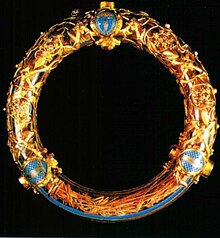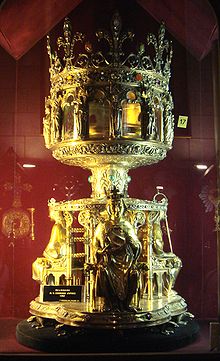Crown of thorns


The crown of thorns ( Greek : στέφανος ἐξ ἀκανθῶν , stéfanos ex akanthón , literally "wreath of thorns") is a term from the Bible .
Biblical mention
Three of the four Gospels report that Jesus of Nazareth was put on a wreath of thorns by Roman soldiers ( Mt 27.29 EU , Mk 15.17 EU and John 19.2 EU ). Together with a reed as a scepter and a red cloak, the soldiers equipped him with "royal" symbols as a mockery ( mockery of Christ ), while they abused and mocked him ( Mt 27.27-31 EU , Mk 15.16-20 EU Joh 19.2-3 EU ).
meaning
As a rule, a crown is an award before a third party and is an expression of power and dignity as well as a symbol of the rule of the wearer. In contrast to this, the crown of thorns was turned into its opposite by the soldiers and thus used as an instrument of degradation, mockery and shame.
Another reinterpretation takes place in Christianity : In it the crown of thorns becomes an important element of the passion and an expression of the suffering of Jesus Christ .
Representation in art
While in early Christianity Jesus is depicted as the majestic victorious figure over death with a laurel wreath (Passion sarcophagus Lateran No. 171, around 340/370) and in Romanesque Jesus is usually depicted on the cross with a raised expression and wears a royal crown, in the Middle Ages the extreme intensification of the moment of suffering and the depiction of the torment of the crucified, with the crown of thorns on the head. The crowning of thorns was particularly popular north of the Alps. With the beginning of the Gothic period , instead of a royal crown, the crown of thorns became an attribute of Christ crucified . At first the crown of thorns was often depicted in the shape of a hood. In the course of the Gothic period, the shape of the crown of thorns developed. In Central Europe a crown was hoop-shaped, in the Middle East it was dome-shaped. Images of the crucified with a crown of thorns in the shape of a hood come mainly from the eastern art area.
relic
According to tradition, a crown of thorns relic is said to have been venerated in Jerusalem in 1036 . During the crusades many relics came to Europe, after the fourth crusade the passion relics “Christ's Crown of Thorns” and parts of the “ True Cross ” as well as the tip of the Holy Lance came to Venice ( list of looted art from the plundering of Constantinople 1204 ). In 1238, the French King Louis IX bought. the saint handed them over to the Latin emperor Baldwin II , who ruled Constantinople , for an astronomical sum . For the relics, Ludwig IX. the saint in Paris built the Sainte-Chapelle, completed in 1248, based on the model of the Pharos palace chapel as the new central mystery shrine of Christianity in the Gothic style. The crown stayed there until the French Revolution .
During the revolution, the crown of thorns was kept in the Vatican for protection . There she was separated into two parts. One part remained in the Vatican to this day. Victor-Augustin-Isidore Dechamps (1810–1883), Archbishop of Mechelen and Primate of Belgium, is said to have detached a fragment from the crown in the Vatican and provided it with his cardinal seal as proof of authenticity. The other half of the crown of thorns relic was stored in the Bibliothèque Nationale for a while after the revolution and was given to the Notre-Dame Cathedral under Emperor Napoleon . At that time, new precious reliquaries were made for safekeeping . One by order of the emperor, another made of jeweled rock crystal based on designs by the influential restorer Eugène Viollet-le-Duc .
In addition, it is reported that Count Rasso is said to have brought a branch from the crown of thorns, a piece of the cross of Christ and remains of the cloth of Christ with him to Andechs from a pilgrimage to the Holy Land in the 10th century. The branch of the crown of thorns is still in the Andechs monastery .
During the fire in the roof beams of the Cathedral of Notre-Dame in 2019 , the crown of thorns relic was rescued from the cathedral and taken to the Paris City Hall for safekeeping and then to the Louvre for temporary storage.
heraldry
As a widespread representation in heraldry , the stylized crown of thorns can also be found in coats of arms .
plant
The plant from which the crown was woven is not mentioned in the Gospels. The following plants are considered:
- Christ thorn ( Paliurus spina-christi )
- Thorny Bibernelle ( Sarcopoterium spinosum (L.))
- Syrian Christ thorn ( Ziziphus spina-christi (L.))
- Purgier buckthorn ( Rhamnus catharticus L.)
- Hawthorn ( Crataegus spec.)
After pollen and prints of the until then rather unknown thistle-like plant Gundelia tournefortii from the tribe Cichorieae (also sunflower) were discovered on the Turin shroud , this is considered an alternative by some botanists.
Patronage
See also
literature
- Alexei Lidov: A Byzantine Jerusalem. The Imperial Pharos Chapel as the Holy Sepulcher . In: Annette Hoffmann, Gerhard Wolf (ed.): Jerusalem as narrative space - Erzählraum Jerusalem (= Visualizing the Middle Ages Vol. 6). Brill, Leiden-Boston 2012, pp. 63-103 ( digitized version ).
- Genoveva Nitz: Article “Crowning Thorns”, Lexicon for Theology and Church, Volume 3, special edition as revised edition of the 3rd edition 1993–2001, Freiburg, Basel, Vienna 2009, Sp. 345–346.
Web links
Individual evidence
- ↑ Vlg. Lexicon for Theology and Church , Herder 1995, Volume 3, p. 364
- ↑ Beyars: Jesus Christ.
- ↑ https://www.saarbruecker-zeitung.de/saarland/saarlouis/schmelz/vom-splitter-der-dornenkrone_aid-1497343
- ↑ Alexei Lidov, 2012, p. 82.
- ↑ https://www.saarbruecker-zeitung.de/saarland/saarlouis/schmelz/vom-splitter-der-dornenkrone_aid-1497343
- ↑ https://www.saarbruecker-zeitung.de/saarland/saarlouis/schmelz/vom-splitter-der-dornenkrone_aid-1497343
- ↑ The "Holy Treasure". Retrieved July 2, 2019 .
- ↑ Central France is on fire. In: The time. April 16, 2019, accessed July 2, 2019 .
- ↑ The Rescue of the Copper Rooster. In: Spiegel Online. April 17, 2019, accessed July 2, 2019 .
- ^ Spiegel Online: Botany


